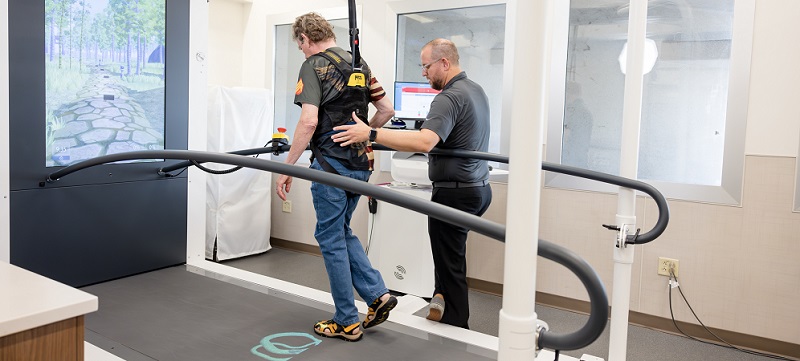
Alzheimer’s Disease and Dementia
Overview
Alzheimer’s disease is a brain condition that slowly affects memory, thinking, and behavior. It is the most common cause of dementia, which is a general term for problems with memory, thinking, and daily functioning that get worse over time. In Alzheimer’s, changes in the brain, like the buildup of harmful proteins, damage brain cells, making it harder to remember things, think clearly, or carry out simple tasks.
While it mainly affects older adults, it is not a normal part of aging. Alzheimer’s gets worse over time, but treatments and support can help people manage their symptoms and maintain their quality of life for as long as possible.
How is dementia different from Alzheimer’s disease?
Dementia is the term for loss of independence due to cognitive impairment. Dementia is a category of disease (much like cancer); it’s a cluster of symptoms that often happen together and can be caused by multiple conditions or diseases.
Contrary to popular belief, dementia is not a normal part of aging. It’s caused by damage to brain cells that affects their ability to communicate, which in turn disrupts a person’s thinking, feelings, and behaviors. People with dementia typically encounter significant memory and speech problems, have difficulty with abstract thinking, and experience poor judgment.
There are multiple causes of dementia, including:
- Alzheimer’s Disease accounts for 60 to 80 percent of all dementia cases, with symptoms that can range from mild to severe. It is a neurodegenerative condition, which means the disease affects the nervous system and progressively worsens over time.
- Vascular Dementia: The second most common cause of dementia after Alzheimer’s, vascular dementia happens when there is decreased blood flow to the brain following a minor stroke or other vascular issues, causing cognitive impairment.
- Lewy Body Dementia: Abnormal protein deposits in the brain called Lewy bodies in the brain cause this form of dementia, which has symptoms including cognitive decline and mobility issues, similar to Alzheimer’s.
- Frontotemporal Degeneration (FTD): FTD (also called frontotemporal dementia) is a group of disorders caused by the degeneration of the frontal and temporal lobes of the brain. It causes personality and behavioral changes and trouble with planning, problem solving, and adjusting to new circumstances.
- Mixed Dementia: This type of dementia most often involves Alzheimer’s disease combined with vascular dementia. This entanglement of two or more forms of dementia frequently makes its progression complicated.
What causes Alzheimer’s disease?
With Alzheimer’s disease, two specific changes happen at the same time:
- Inside of Brain Cells: Abnormal accumulations of tau proteins begin to form, causing neurofibrillary tangles. These tangles interfere with the transport system inside the cells and prevent them from functioning as they should.
- Outside of Brain Cells: Another abnormal protein called beta-amyloid is deposited in the brain’s gray matter. These are known as amyloid plaques, and they slowly begin to disrupt communication between brain cells.
At first, the number of tangles and plaques is small and primarily found in the areas of the brain that are important for memory. Over time, their number increases and spreads, leading to the death of vital brain cells. This, in turn, causes the brain to shrink dramatically, affecting nearly all of its functions.
While the exact cause of Alzheimer’s isn’t fully understood, experts think the disease is due to a combination of genetic, environmental, and health factors that affect the brain over time.
Contributing factors can include:
- Age: The most significant risk factor for Alzheimer’s is age, as most people with Alzheimer’s are 65 and older.
- Genetic Factors: If Alzheimer’s runs in your family, your risk may be higher. In rare cases, due to specific genetic mutations, people in their 30s to 60s can develop early-onset Alzheimer’s. Individuals with Down’s syndrome are also at a higher risk of developing Alzheimer’s, as the chromosomal abnormalities that cause Down’s syndrome can also spur amyloid plaques to form in the brain.
- Medical and Health Conditions: Heart and blood vessel conditions, like high blood pressure, high cholesterol, and diabetes, can increase the risk of Alzheimer’s. Other factors—poor diet, lack of exercise, smoking, and low social and mental engagement—also contribute.

How Alzheimer’s Dementia Progresses
In early Alzheimer’s, the part of the brain associated with learning is affected first. As the disease progresses, symptoms become much more severe—and eventually, actions like speaking and walking become difficult.
Preclinical Alzheimer’s Disease
- Stage 1: No symptoms present, but the changes that will manifest in Alzheimer’s are already beginning in the brain.
- Stage 2: People in this stage perform normally on cognitive tests, but there may be a barely detectable decline in mental function. Daily function is not impacted or minimally impacted.
Mild Cognitive Impairment
- Stage 3: Mental impairment is evident in cognitive test results, but daily life is not significantly impacted.
Alzheimer’s Dementia
- Stage 4 (Mild Dementia): In the early stage of Alzheimer’s, people can often continue to function independently. Despite this, it may feel like an increasing number of memory lapses are happening, like forgetting familiar words or recently studied material, a new difficulty with organizing or planning, and losing or misplacing everyday objects.
- Stage 5 (Moderate Dementia): Typically the longest stage of Alzheimer’s, the middle stage has more pronounced symptoms. A person may confuse words, be quick to anger, and act out in new or unexpected ways. Damage to your brain’s neurons can make it hard to communicate and complete routine tasks without assistance.
- Stage 6 (Severe Dementia): The final stage of Alzheimer’s has severe symptoms. The ability to converse, respond to the surrounding environment, and control movement is eventually lost. Significant personality changes take place as memory and cognitive skills continue to decline. At this stage, many struggle to communicate and often require around-the-clock assistance.
Alzheimer’s Disease and Dementia Symptoms
New or unusual memory loss that disrupts daily life is the leading symptom of dementia, including Alzheimer’s disease. These symptoms usually develop slowly over time, although they may appear to start abruptly or worsen after an injury, illness, or an operation.
The following are some of the earliest symptoms you might notice if you or someone you know has Alzheimer’s or another form of dementia:
- Memory loss that disrupts your day-to-day life: One of the most common signs of early-stage Alzheimer’s is forgetting new information or important dates or events. This is because the hippocampus, which is responsible for memory, is one of the first parts of the brain to be damaged.
- New difficulty with familiar tasks: A newfound difficulty concentrating or taking much longer to do things than before, like driving to a familiar location or managing monthly bills, can indicate early Alzheimer’s disease.
- Misplacing items and requiring help retracing steps: Losing items, putting them in unusual places, and needing help finding them again become more common.
- Confusion of time and place: Losing track of dates, seasons, and the passage of time, or forgetting where you are or how you got there, is a common symptom.
- Trouble understanding images and relationships of objects in space: Due to vision changes, problems judging distance and determining color or contrast can lead to difficulty reading, balancing, and even driving.
- Problems with conversation and articulation: Having trouble following a conversation, stopping in the middle of one not knowing how to continue, or repeating yourself are common experiences. These changes can cause you to withdraw from previously loved hobbies or social activities.
- Changes in mood or personality: Becoming unusually frustrated, suspicious, depressed, or anxious, either at home or when out of your comfort zone, often occur.
- Bad judgment: Changes in decision-making, such as poor financial choices or paying less attention to personal hygiene, can indicate dementia or Alzheimer’s.
If you notice one or more of these signs, it can take time to know how to proceed. Yet it’s crucial to get to the root cause, as these are significant concerns that require a careful evaluation by an experienced healthcare professional. With early detection, you or your loved one can explore treatments that can relieve symptoms and encourage greater independence over a more extended period.
| Normal Age-Related Changes | Signs of Alzheimer’s Disease |
|---|---|
| Occasionally making a bad decision | Overall poor judgment and decision-making |
| Forgetting a monthly payment | Complete inability to manage a budget |
| Briefly forgetting which day it is | Losing track of the date or season |
| Struggling to find the right word | Unusual difficulty holding a conversation |
| Losing things from time to time | Misplacing objects and being unable to retrace your steps |
A Note on Menopause and Cognitive Complaints
While minor changes in memory are entirely normal, it’s important to highlight that a change in hormones can also intensify memory loss.
As women begin to go through the menopause transition in their late thirties to mid-fifties, they’ll often worry that symptoms like memory lapses, brain fog, and difficulty concentrating are emblematic of early warning signs of dementia.
It’s reassuring to know these symptoms do not universally signal dementia, especially once age is taken into consideration. Alzheimer’s disease and dementia are most common in women over the age of 65; not so for menopause. More often than not, these symptoms in women between the ages of 35 and 55 are due to waning estrogen, which has protective effects on the brain and its ability to function. As estrogen starts to dip and eventually reaches equilibrium at a much lower level post-menopause, there are noticeable and somewhat predictable—although perhaps unexpected—side effects like brain fog.
That said, navigating the blurry lines of “Is this a symptom of menopause?” versus “Is this an early symptom of dementia?” can warrant a thoughtful conversation with your healthcare provider. Ultimately, the relationship between menopause and dementia is complex and calls for a considerate approach, as well as more conclusive research.

Alzheimer’s Disease and Dementia Diagnosis
Unfortunately, no single test can determine if a person has dementia or Alzheimer’s disease. Instead, information from neurological exams, cognitive assessments, brain imaging, and blood and cerebrospinal fluid (CSF) testing is needed. What’s more, it may take several appointments over multiple months before your physician can confirm a diagnosis of Alzheimer’s disease.
Exams and Testing
- Physical and neurological exam: First, your healthcare provider will ask about your overall health and symptoms, as well as review your medical history, including psychiatric history and conditions affecting family members. Next, your provider will complete an exam to assess your neurological function, including reflexes, coordination, strength, and sensation.
- Cognitive, functional, and behavioral tests: Cognitive, functional, and behavioral tests evaluate memory, thinking, and problem-solving abilities to detect changes. Some tests are brief, while others can be more time-intensive—often, a neuropsychologist is enlisted to analyze executive function and judgment.
- Depression screen and mood assessment: Your provider will also evaluate your overall sense of well-being to detect or rule out depression or another mood disorder that can cause symptoms that appear to mimic dementia.
Imaging
Magnetic Resonance Imaging (MRI): MRI can reveal tumors, evidence of strokes, damage from head trauma, or a buildup of fluid (hydrocephalus) using detailed images of the brain to identify any abnormalities that can cause symptoms similar to Alzheimer’s dementia. However, MRI is no longer used only to exclude other diagnoses. It can also offer important clues that can point to a positive diagnosis.
For example, MRI can show whether certain brain parts are shrinking. In people with Alzheimer’s, the hippocampal, medial temporal, and parietal regions often become smaller. MRI can also detect thinning in the brain’s outer layer, called the cortex, especially in areas responsible for thinking and memory.
Doctors sometimes use advanced MRI techniques to measure brain volume more precisely. Special software can compare the size of your brain regions to what is considered normal for your age.
Functional Magnetic Resonance Imaging (fMRI) is also used to identify decreased activity in the hippocampal and medial temporal areas during tasks requiring memory use.
Amyloid Positron Emission Tomography (PET) scan: An amyloid PET scan is a type of brain imaging that helps doctors see if there are abnormal protein deposits, called amyloid plaques, in your brain. The buildup of these plaques is the earliest change that occurs in the brain of a person with Alzheimer’s disease.
During the scan, a safe, low-dose radioactive tracer is injected into your bloodstream, which travels to your brain and attaches to the amyloid plaques. The PET scanner then takes detailed images showing where these plaques are located. If your doctors see a large number of these plaques, it can help confirm an Alzheimer’s diagnosis or show that you may be in the early stages of the disease. This painless scan allows your doctor to understand what might be causing memory problems or other symptoms.
Blood and Cerebrospinal Fluid Tests
Cerebrospinal fluid (CSF) tests: A clear fluid cushioning the brain and spinal cord, your CSF can be sampled through a minimally invasive lumbar puncture, or spinal tap. Research has suggested that early-stage Alzheimer’s may cause changes in CSF levels of multiple markers, like tau and beta-amyloid, that form brain deposits strongly linked to Alzheimer’s.
Blood-based biomarkers are the newest method for helping to diagnose Alzheimer’s disease. These tests look for specific proteins or blood changes related to Alzheimer’s, such as amyloid beta and tau proteins, which are known to build up in the brain during the disease. By measuring these markers in your blood, doctors can get clues about what might be happening in your brain. These tests are less invasive and more affordable than other methods like brain scans or spinal taps.
While blood tests for Alzheimer’s are still being refined, they are becoming more reliable. They can help identify the disease earlier, even before symptoms become severe. This means they can support an early diagnosis, allowing quicker treatment and better planning for the future.

Alzheimer’s Disease and Dementia Treatment
At this time, there is no cure for dementia or Alzheimer’s disease. Still, numerous medications and treatments can influence disease progression and help with a host of symptoms.
Medication
Three different classes of medication are approved for Alzheimer’s disease. These medications can only be prescribed by doctors, usually neurologists or psychiatrists.
The first class, called cholinesterase inhibitors, includes three drugs that increase levels of acetylcholine, a substance in the brain that helps nerve cells communicate. This, in turn, improves cognitive ability and overall symptoms. All three cholinesterase inhibitors are generally well tolerated and include:
- Donepezil (Aricept): This drug, which is taken orally, is approved for all stages of Alzheimer’s disease.
- Galantamine (Razadyne): Galantamine is approved for early- to middle-stage Alzheimer’s and is available as a capsule, liquid, or transdermal patch.
- Rivastigmine (Exelon): This drug, available as an extended-release tablet, capsule, or liquid, is also approved for early- to middle-stage Alzheimer’s.
The second class, called NMDA receptor antagonists, includes:
- Memantine (Namenda): This drug works differently than cholinesterase inhibitors by blocking specific receptors in the brain that can protect nerve cells from too much stimulation. Neurologists prescribe it for moderate to severe Alzheimer’s and in combination with one of the cholinesterase inhibitor drugs above.
Monoclonal antibodies are the newest class of treatment for Alzheimer’s. They are intravenous drugs that target amyloid and slow decline. They include:
- Lecanemab (Leqembi): Approved by the FDA in early 2023, lecanemab targets and binds to beta-amyloid proteins and prevents them from clustering to form the plaques contributing to disease progression. To date, lecanemab is most beneficial for those with early signs of Alzheimer’s-related cognitive decline. However, more research and long-term studies are crucial to fully understanding the drug’s benefits and risks.
- Donanemab (Kisunla): Donanemab also targets amyloid plaques but focuses on a specific type of amyloid called modified pyroglutamate amyloid. This type of amyloid is found mainly in the plaques themselves. Because Donanemab targets established plaques, it may work best in the early stages of Alzheimer’s. The treatment is given through an IV infusion once a month. The FDA approved it for Alzheimer’s patients in 2024.
Because people with Alzheimer’s can develop depression, antidepressants are sometimes given alone or in conjunction with counseling. A small percentage of people may see or hear things that aren’t there, which is known as hallucination. In this case, doctors may prescribe small doses of antipsychotic drugs.
While none of these drugs can reverse Alzheimer’s disease, they can offer a stabilization of symptoms or even a modest level of improvement. Studies have shown that individuals with Alzheimer’s who take these medications do better over time than those who do not.
Cognitive and Physical Rehabilitation
Medications are only part of the puzzle in caring for someone with dementia—this is where cognitive rehabilitation comes in. Offering a blend of “skills training” tailored to each patient, cognitive rehabilitation can include several weeks of themed activity sessions through cognitive stimulation therapy (CST) or life story work, where patients are encouraged to record their memories and life experiences. Life story work is invaluable in early dementia, as patients can no longer share this same information in the later stages of the disease.
In the advanced stages of Alzheimer’s disease, some patients develop problems with walking, balance, and muscle tone. This is where physical therapy can help. At our inclusive Alzheimer’s and Memory Disorders Program at Barrow Neurological Institute, our highly trained rehabilitation team can help care for patients with specific and individualized care plans in inpatient and outpatient settings.

Clinical Trials
Barrow Neurological Institute is also home to multi-site clinical trials for patients in various stages of cognitive decline. We lead prevention studies focused on finding a cure for Alzheimer’s and other dementias, and we serve as a study site for the largest international trial to date to evaluate deep brain stimulation (DBS) surgery for mild probable Alzheimer’s.
We’re always looking for volunteers to participate in clinical trials so that we can better understand, diagnose, treat, and ultimately prevent Alzheimer’s disease. You don’t have to have a form of dementia to participate, as control groups (people without signs of the disease) help scientists better understand how the brain changes in healthy, routine aging and in Alzheimer’s disease. Learn more here.
Common Questions
How common is Alzheimer’s disease?
Unfortunately, Alzheimer’s is an all-too-common disease. Approximately 6.5 million people in the U.S. 65 and older are living with Alzheimer’s, and doctors diagnose nearly 500,000 new cases each year.
These numbers are expected to rise as our population ages: every five years, the number of people living with the disease after age 65 doubles. Even more alarming, this number will nearly triple to 14 million people by 2060.
Who gets Alzheimer’s?
Alzheimer’s disease is most common over the age of 65, and more than one-third of the population over age 85 is affected. While younger people can be diagnosed with Alzheimer’s disease, it’s less common.
Alzheimer’s disease is also more common in women than in men. The risk for developing the disease at 45 years is 20 percent for women and ten percent for men.
While untreated high blood pressure, high cholesterol, obesity, diabetes, and physical or mental inactivity can increase the risk of developing Alzheimer’s, heredity and genetics likely play a more significant role. People who have a parent or sibling with Alzheimer’s disease have a greater risk than someone without a family history. That said, having a relative with the disease does not mean that you’re going to get Alzheimer’s.
What is the prognosis for people diagnosed with Alzheimer’s disease?
The prognosis for a person with Alzheimer’s disease heavily depends on several factors, including age, overall health, the stage of disease at diagnosis, and the care and support given after diagnosis.
Alzheimer’s disease is ranked as the seventh leading cause of death in the U.S. and the fifth leading cause of death in adults 65 and older. The average life expectancy after an Alzheimer’s diagnosis is between 4 and 8 years. Still, some individuals live as long as 20 years after diagnosis.
Can Alzheimer’s disease or dementia be prevented?
While there is no sure-fire way to prevent either condition, research suggests that the following lifestyle choices can help:
- Mental and social engagement: As we age, keeping our brains engaged in activities like learning new skills, solving puzzles, and reading is critical. Maintaining social connections also boosts overall mental health.
- Healthy diet: Limiting sugary and fatty foods can be beneficial, and a diet rich in vegetables, fruits, whole grains, fish, and healthy fats like olive oil may help reduce your risk.
- Healthy lifestyle: Smoking is a risk factor for many diseases, including Alzheimer’s. Excessive alcohol consumption can also increase the risk of cognitive decline.
- Physical activity: Engaging in physical activity improves overall brain health and can reduce the risk of cognitive decline.
- Heart health: Keeping cholesterol and blood sugar levels in check can protect our brains. So, too, can managing blood pressure, as high blood pressure is linked to an increased risk of Alzheimer’s.
If you are experiencing concerns about your cognitive health, it’s always a good idea to discuss them with a trusted healthcare provider.
Additional Resources
CDC – Alzheimer’s Disease and Related Dementias
National Institutes of Health – What is Alzheimer’s disease?
References
- Ankeny SE, Bacci JR, Decourt B, Sabbagh MN, Mielke MM. Navigating the Landscape of Plasma Biomarkers in Alzheimer’s Disease: Focus on Past, Present, and Future Clinical Applications. Neurol Ther. 2024 Dec;13(6):1541-1557. doi: 10.1007/s40120-024-00658-x. Epub 2024 Sep 7. PMID: 39244522; PMCID: PMC11541985.
- Mielke MM, Anderson M, Ashford JW, Jeromin A, Lin PJ, Rosen A, Tyrone J, VandeVrede L, Willis D, Hansson O, Khachaturian AS, Schindler SE, Weiss J, Batrla R, Bozeat S, Dwyer JR, Holzapfel D, Jones DR, Murray JF, Partrick KA, Scholler E, Vradenburg G, Young D, Braunstein JB, Burnham SC, de Oliveira FF, Hu YH, Mattke S, Merali Z, Monane M, Sabbagh MN, Shobin E, Weiner MW, Udeh-Momoh CT. Considerations for widespread implementation of blood-based biomarkers of Alzheimer’s disease. Alzheimers Dement. 2024 Nov;20(11):8209-8215. doi: 10.1002/alz.14150. Epub 2024 Oct 6. PMID: 39369283; PMCID: PMC11567842.
- Noorda K, Noorda K, Sabbagh MN, Bertelson J, Singer J, Decourt B. Amyloid-Directed Antibodies: Past, Present, and Future. J Alzheimers Dis. 2024;101(s1):S3-S22. doi: 10.3233/JAD-240189. PMID: 39422953.
- Honig LS, Sabbagh MN, van Dyck CH, Sperling RA, Hersch S, Matta A, Giorgi L, Gee M, Kanekiyo M, Li D, Purcell D, Dhadda S, Irizarry M, Kramer L. Updated safety results from phase 3 lecanemab study in early Alzheimer’s disease. Alzheimers Res Ther. 2024 May 10;16(1):105. doi: 10.1186/s13195-024-01441-8. Erratum in: Alzheimers Res Ther. 2024 Jul 10;16(1):159. doi: 10.1186/s13195-024-01507-7. PMID: 38730496; PMCID: PMC11084061.
- Burke AD, Goldfarb D. Diagnosing and Treating Alzheimer Disease During the Early Stage. J Clin Psychiatry. 2023 Mar 22;84(2):LI21019AH3C. doi: 10.4088/JCP.LI21019AH3C. PMID: 36946604.




